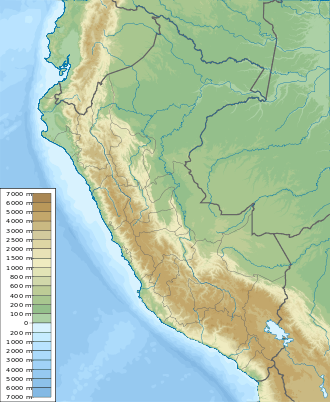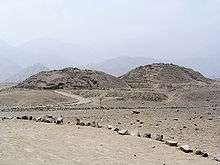Caral
Caral, or Caral-Chupacigarro,[1] was a large settlement in the Supe Valley, near Supe, Barranca Province, Peru, some 200 kilometres (120 mi) north of Lima. Caral is the most ancient city of the Americas and a well-studied site of the Norte Chico civilization.
Remains of Caral | |
 Shown within Peru | |
| Alternative name | Caral-Supe |
|---|---|
| Location | Lima Region, Peru |
| Coordinates | 10°53′37″S 77°31′13″W |
| Type | Settlement |
| History | |
| Founded | c. 2600 BCE |
| Abandoned | c. 2000 BCE |
| Cultures | Norte Chico |
| Site notes | |
| Condition | In ruins |
| Official name | Sacred City of Caral-Supe |
| Location | Supe District, Barranca Province, Peru |
| Criteria | Cultural: (ii), (iii), (iv) |
| Reference | 1269 |
| Inscription | 2009 (33rd session) |
| Area | 626.36 ha (2.4184 sq mi) |
| Buffer zone | 14,620.31 ha (56.4493 sq mi) |
| Website | www |
The city was declared a UNESCO World Heritage Site in 2009.[2]
History
Caral was inhabited roughly between the 26th and 20th centuries BCE,[3] enclosing an area of more than 60 hectares (150 acres).[4] Caral was described by its excavators as the oldest urban centre in the Americas, a claim that was later challenged as other ancient sites were found nearby, such as Bandurria, Peru. Accommodating more than 3,000 inhabitants, it is the best studied and one of the largest Norte Chico sites known.
 The Caral temples in the arid Supe Valley, some 20 km from the Pacific coast.
The Caral temples in the arid Supe Valley, some 20 km from the Pacific coast.
Archaeological findings
Paul Kosok discovered Caral in 1948, but it received little attention at the time because it appeared to lack many typical artifacts that were sought at archaeological sites throughout the Andes. In 1975, the Peruvian architect Carlos Williams made a detailed record of most of the archaeological sites of the valley of Supe, among which he recorded Caral, from which he made some observations about the development of architecture in the Andes. Ruth Shady further explored the 4,000- to 4,600-year-old city in the Peruvian desert, with its elaborate complex of temples, an amphitheatre and ordinary houses.[5] The urban complex is spread out over 150 hectares (370 acres) and contains plazas and residential buildings. Caral was a thriving metropolis at roughly the same time that Egypt's great pyramids were being built.
Caral is the largest recorded site in the Andean region with dates older than 2000 BCE and appears to be the model for the urban design adopted by Andean civilisations that rose and fell over the span of four millennia. It is believed that Caral may answer questions about the origins of the Andean civilisations and the development of the first cities.
Among the artefacts found at Caral are a knotted textile piece that the excavators have labelled a quipu. They write that the artefact is evidence that the quipu record keeping system, a method involving knots tied in rope that was brought to perfection by the Inca Empire, was older than any archaeologist had previously guessed. Evidence has emerged that the quipu may also have recorded logographic information in the same way writing does. Gary Urton has suggested that the quipus used a binary system which could record phonological or logographic data.
Main temple
The main temple complex (Spanish: Templo Mayor) is 150 meters (490 ft) long, 110 meters (360 ft) wide and 28 meters (92 ft) high. The date of its construction is unknown.
Peaceful society
No trace of warfare has been found at Caral: no battlements, no weapons, no mutilated bodies. Shady's findings suggest it was a gentle society, built on commerce and pleasure. In one of the temples, they uncovered 32 flutes made of condor and pelican bones and 37 cornetts of deer and llama bones. One find revealed the remains of a baby, wrapped and buried with a necklace made of stone beads.[5]
Scope of site
Caral spawned 19 other temple complexes scattered across the 90 square kilometres (35 sq mi) area of the Supe Valley.
The date of 2627 BCE is based on carbon dating reed and woven carrying bags that were found in situ. These bags were used to carry the stones that were used for the construction of the temples. The material is an excellent candidate for high precision dating. The site may date even earlier as samples from the oldest parts of the excavation have yet to be dated.[6] The town had a population of approximately 3000 people.
However, the 19 other sites in the area (posted at Caral), allow for a possible total population of 20,000 people for the Supe Valley. All of these sites share similarities with Caral. They had small platforms or stone circles. Shady believes that Caral was the focus of this civilisation, which itself was part of an even vaster complex, trading with the coastal communities and the regions further inland – as far as the Amazon, if the depiction of monkeys is any indication.[5]


Geoglyph
In 2000, Marco Machacuay (the chief of excavations at the time) and his colleague, Rocío Aramburú, discovered a large shape etched on the ground in circular stone lines near Caral. This image, known as a geoglyph, is located on the desert floor just west of the main site at Caral. When traced out, the lines form the design of a human face with long, streaming hair and a gaping mouth.
This geoglyph is similar to the screaming, bleeding figures found etched onto the stone walls at a site called Cerro Sechín, in the Casma Valley 240 kilometres (150 mi) to the north. It is unclear what exactly this figure means, but it is believed to have been constructed around the same time as Caral and to have been associated with a nearby ceremonial site known as Chupacigarro.[7]
Musical instruments
Another significant find on the site was a collection of musical instruments, including 37 cornetts made of deer and llama bones and 33 flutes of unusual construction.[8] The flutes were radiocarbon dated to 2170±90 BCE.[5]
See also
References
- Adelaar, Willem (2004). The Languages of the Andes. Cambridge University Press. p. 2. ISBN 978-1-139-45112-3.
- UNESCO World Heritage Centre.
- Eurekalert.org, "Oldest evidence of city life in the Americas reported in Science, early urban planners emerge as power players" Public release date: 26-Apr-2001 American Association for the Advancement of Science
- NYtimes.com, "Archaeological Site in Peru Is Called Oldest City in Americas" Public release date: 27-Apr-2001 The New York Times
- Shady, R. Haas, J. Creamer, W. (2001). Dating Caral, a Pre-ceramic Site in the Supe Valley on the Central Coast of Peru. Science. 292:723-726. doi:10.1126/science.1059519 PMID 11326098 ncbi.nlm.nih.gov
- Belsie, Laurent (3 January 2002). "Civilization lost?". Christian Science Monitor.
- Atwood, Roger. "A Monumental Feud." Archaeology. Jul/Aug 2005, Vol. 58 Issue 4, pp. 18-25.
- Ross, John (August 2002). "First City in the New World?". Smithsonian Museum. Archived from the original on 2 March 2013. Retrieved 30 November 2012.
External links
| Wikimedia Commons has media related to Caral-Supe. |
- Official website features 3-D renderings of major monument; accessed 24 January 2017.
- UNESCO – Sacred City of Caral-Supe (World Heritage)
- The History of the Quipu: South America's Writing Technology : Quipu Knotted String Technology Record Keeping at Least 1,200 Years Old
- Transcript of BBC Horizon program about Caral; accessed 24 January 2017.
- Gigapan Caral high resolution panorama of Caral.
- La Zona Arqueológica Caral